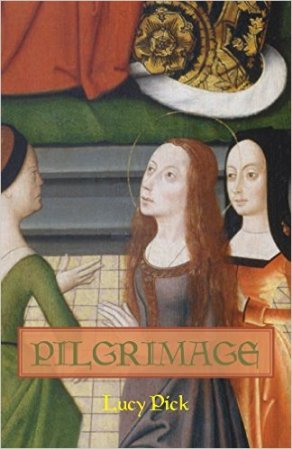 In medieval Europe, religious devotion provided an alternate narrative for women’s lives in a male-dominated culture. Defiant women who stood up for themselves in the face of rape, incest, and murder were hailed as virgin martyrs. Religious vocations, such as becoming a nun or a beguine, provided a viable and esteemed alternative to forced marriage.
In medieval Europe, religious devotion provided an alternate narrative for women’s lives in a male-dominated culture. Defiant women who stood up for themselves in the face of rape, incest, and murder were hailed as virgin martyrs. Religious vocations, such as becoming a nun or a beguine, provided a viable and esteemed alternative to forced marriage.
Even women who were married with children could escape their domestic entanglements and conjugal duties by taking an oath of celibacy as 15th century English mystic Margery Kempe did, leaving behind her husband and 14 children to go on pilgrimage to Santiago de Compostela, Rome, and Jerusalem. Her Book of Margery Kempe, the tale of her travels, reads like a kind of late medieval Eat, Pray, Love and is the first autobiography written in the English language.
Though it might seem surprising to us today, women of the European Middle Ages possessed more rights and freedoms than their descendants in the Renaissance, Early Modern, and Victorian ages. Women worked as craftspeople and artisans and were members of the guilds, alongside men. Monarchs such as Eleanor of Aquitaine were global power brokers while religious leaders such as Hildegard von Bingen devoted their lives to intellectual and artistic pursuits, composing music and writing weighty philosophical and theological books that are still being discussed today.
 The cover of academic historian Lucy Pick’s novel Pilgrimage shows details from a painted altarpiece dedicated to Saint Godeleva. A victim of forced marriage who was strangled by order of her husband, this legendary saint was a patron of abused wives. Lucy Pick’s novel concerns the saint’s daughter, the blind Gebirga of Gistel in Flanders. What would it be like to be the daughter of a martyred saint whose miracles cured everyone except you?
The cover of academic historian Lucy Pick’s novel Pilgrimage shows details from a painted altarpiece dedicated to Saint Godeleva. A victim of forced marriage who was strangled by order of her husband, this legendary saint was a patron of abused wives. Lucy Pick’s novel concerns the saint’s daughter, the blind Gebirga of Gistel in Flanders. What would it be like to be the daughter of a martyred saint whose miracles cured everyone except you?
Considered unmarriageable due to her blindness, Gebirga rejects life as a nun in an abbey dedicated to her sainted mother. Instead, in a bid for freedom, she embarks on a pilgrimage to Santiago de Compostela in faraway Iberia, an epic journey for that time. She serves as the companion to a highly strung teenage noblewoman and is charged with delivering the girl to the Spanish king she is contracted to marry. During their travels, Gebirga must use all her intelligence and resourcefulness to protect herself and her young charge from the considerable dangers and political intrigues they face on their way. Though they encounter hardship and heartbreak, this is a pilgrimage of miracles, healing, and redemption.
Lucy Pick, the Director of Undergraduate Studies and Senior Lecturer at the University of Chicago’s Divinity School, has infused her novel with impeccable research into the lives of medieval women. This novel is a medievalist’s delight and fans of the late Margaret Frazer will devour this book.
Mary Sharratt’s book Illuminations: A Novel of Hildegard von Bingen, won the 2013 Nautilus Gold Award, Better Books for a Better World. Her forthcoming novel, The Dark Lady’s Mask: A Novel of Shakespeare’s Muse, tells the tale of the groundbreaking Renaissance women poet Aemilia Bassano Lanier and will be published by Houghton Mifflin Harcourt in April 2016. Visit Mary’s website.


Interesting how women choose pilgrimage–then and now–as a way of finding an alternative spirituality.
LikeLike
In every age, I believe women found their own spirituality through whatever channels existed. Thanks for your comment!
LikeLike
Wonderful! Can’t wait to get started on all of her books. Have ordered Illumination and will start looking for the rest. Thank you.
LikeLike
Thanks so much, Karen. “Pilgrimage” is by author Lucy Pick, if that wasn’t clear. :)
LikeLike
And Illuminations by Mary is a good read too!
LikeLike
Thank you, Barbara Cooper! :)
LikeLike
Thanks for pointing out that the medieval period was in fact better for women in many ways than the Renaissance was. Not many people realize that.
Pilgrimage sounds like a good novel. I think I’ll order it to. (Like I haven’t already got a whole stack of books at the other end of my couch. Ha!)
LikeLike
Joan Kelly, “Did Women Have a Renaissance” made that point.
LikeLike
Here is the article if anyone wants to read it. I was old enough to have read this in college! It truly changed my life. http://isites.harvard.edu/fs/docs/icb.topic205827.files/October_22/Kelly_Did_Women_Have_a_Renaissanace.pdf
LikeLike
So many people see all of women’s history through the lens of the Victorian age, when medieval women had so many freedoms that 19th century Western women didn’t. And the Renaissance was a very regressive period for women, with the witch persecutions enforcing new misogynist norms.
LikeLike
Thank you for letting us know about this novel! I am looking forward to your next novel, too!
LikeLike
Thank you, Elizabeth!
LikeLike
Reblogged this on writingontherim and commented:
I will add this to my list of must reads.
LikeLike